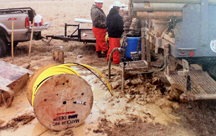
An International Petrochemical Company contracted with MATCOR to review assessment data gathered more than 10 years earlier. MATCOR’s initial findings showed the existing Cathodic Protection System was struggling to maintain criteria. To determine the exact cause of the problems MATCOR launched a comprehensive survey of 20 miles of 26 inch pipeline.
From the initial review of the pipeline, it became clear that the existing Cathodic Protection system did not have the capacity to distribute DC current effectively. MATCOR’s technicians performed Close Interval Surveys (CIS), Pipeline Current Mapping (PCM), and Direct Current Voltage Gradient (DCVG) surveys. In addition, MATCOR took soil samples and had them analyzed, measuring pH, sulfates and sulfides, chlorides and moisture content. The results corresponded with the smart pig runs, which further validated the testing and data analysis. The survey revealed significant coating degradation.
It was clear from the current requirement test results that a new Cathodic Protection System was necessary. The client’s choice was MATCOR’s patented Mini-Deep Anode System, which is very easily installed without disruption to the pipeline.
In all, 15 Mini-Deep Anodes were used to protect 40-plus miles of pipeline and connecting laterals.
MATCOR strategically placed ground beds approximately one mile east and west of the rectifiers. On a new pipeline, each MATCOR Mini-Deep Anode can protect many miles of line, but since these pipelines experienced coating degradation, MATCOR designed the system to protect the existing lines from low structure to electrolyte potentials.
Upon completion of the testing and commissioning of the rectifier and ground bed system, this pipeline system, with associated laterals, was able to achieve -850mV OFF potential throughout its entire length.
The client was concerned that the 100mV criterion would have to be used in certain areas due to poor coating conditions; however, this was not the case. MATCOR achieved complete integrity by incorporating the correct combination of engineering, design, and cooperation from the client.
The Mini-Deep Anodes will protect the system for 20 years or more.







What are you calling a Mini-Deep ground bed, just how deep are you installing the anodes? The 15 mini anodes are all in ONE bed or in multiple beds?
The Mini-Deep Anode system is MATCOR’s trade name for a proprietary deep well anode system using a single continuous MMO wire anode over the entire anode active length with multiple anode to header cable connections.
MATCOR’s unique design comes factory pre-assembled on a reel with an integral continuous vent pipe and is ready to drop down the hole immediately upon completion of the well drilling. For more information on MATCOR’s Mini-Deep Anode system please consult our website.
In this particular case, the total depth of the deep well anode system was 250 feet with 150 feet of active anode and an additional 100 feet of inactive anode.
The anode was rated for 40 amps continuous operation for 30 years. Fifteen separate deep well anodes were installed based on the MATCOR Mini-Deep Anode configuration.
There are two types of pipeline cathodic protection, galvanic and impressed current cathodic protection. What is the difference between them?
Impressed Current Systems use an external power supply to drive current off the anode. This allows the CP system designer to select an anode based on its properties as an anode (current capacity, consumption rate, etc…) The analogy is using a pump in a piping system to provide motive force to move liquids through the system
Galvanic Anode systems utilize the natural potential difference between the anode material and the structure. Since we are generally talking about CP protecting steel or iron, the only metals that can be used are magnesium, zinc and aluminum as these are more electrically negative than steel/iron. The designer has minimal flexibility with these materials – the only driving force is the small difference in potential between the two metals to create a flow of current. The analogy is a gravity fed piping system that relies solely on gravity to induce flow. Great if it works but if it doesn’t work it doesn’t work.
From a design standpoint there are pros and cons of both types of systems, but remember that with galvanic systems, there is no power supply and no means of providing additional driving force to increase current output. With impressed current systems there is a power supply and you can turn the voltage up or down to adjust current output.